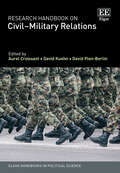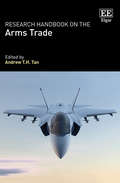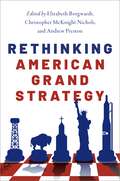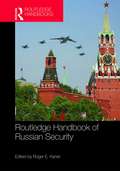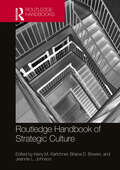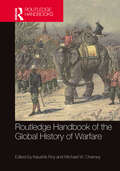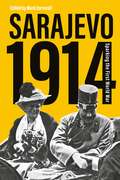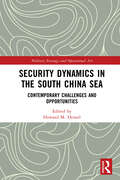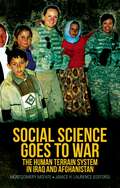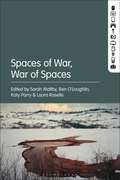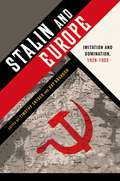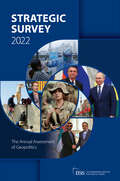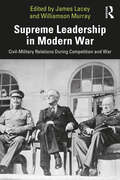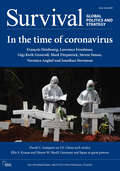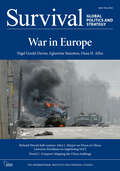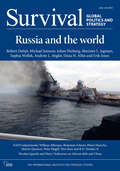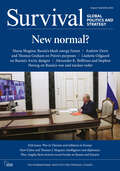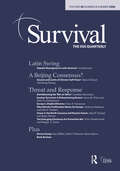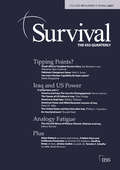- Table View
- List View
Research Handbook on Civil–Military Relations (Elgar Handbooks in Political Science)
Bringing together leading international scholars, this comprehensive Research Handbook analyses key problems, subjects, regions, and countries in civil-military relations. Showcasing cutting-edge research developments, it illustrates the deeply complex nature of the field and examines important topics in need of renewed consideration.Arranged in five thematic sections, chapters explore the role of armed forces in politics and society, the missions and roles of militaries, and crucial issues of control, compliance and effectiveness. Contributors present theoretically informed and empirically applied research asking novel questions and examining cutting-edge solutions to ongoing problems in the field. They demonstrate the wide range of research methodologies and meta-theoretical traditions in civil-military relations, spanning structuralism, behavioralism, institutionalism, and constructivism. Ultimately, the Research Handbook is a timely insight into the contemporary role of militaries, for example in democratization and autocratization processes and deployment during natural disasters and pandemics.The Research Handbook on Civil–Military Relations will be an invaluable resource for students and scholars of military, security, and strategic studies, as well as comparative politics and military sociology. It will also be an important read for policymakers seeking to better understand the role of the military in society.
Research Handbook on the Arms Trade
This comprehensive Research Handbook examines the key drivers of the arms trade, mapping the main trends in Asia, Europe, the Middle East, Africa and Latin America. It also explores the principal defence markets internationally, including the US, China, India, Russia and the UK in greater detail. Across twenty-six chapters, international experts assess the central drivers of the arms trade, such as the insecurities of small states in an increasingly realist world of power politics, the continued presence of conflict, technological change and the presence of corruption. Analysing critical issues from the future of air and naval power and their implications for the trade to the impact of emerging technology and the prospects for arms control, the chapters raise a number of central issues as to the challenges and future direction of the arms trade. The Research Handbook concludes that defence spending and procurement have remained paramount and on a general upward trend since the Cold War, particularly in Asia and the Middle East. This Research Handbook will be a valuable resource for academics and students of international relations, security studies and political science. Its global approach will also be beneficial for arms policy analysts and defence professionals.
Rethinking American Grand Strategy
A wide-ranging rethinking of the many factors that comprise the making of American Grand Strategy. What is grand strategy? What does it aim to achieve? And what differentiates it from normal strategic thought--what, in other words, makes it "grand"? In answering these questions, most scholars have focused on diplomacy and warfare, so much so that "grand strategy" has become almost an equivalent of "military history." The traditional attention paid to military affairs is understandable, but in today's world it leaves out much else that could be considered political, and therefore strategic. It is in fact possible to consider, and even reach, a more capacious understanding of grand strategy, one that still includes the battlefield and the negotiating table while expanding beyond them. Just as contemporary world politics is driven by a wide range of non-military issues, the most thorough considerations of grand strategy must consider the bases of peace and security--including gender, race, the environment, and a wide range of cultural, social, political, and economic issues. Rethinking American Grand Strategy assembles a roster of leading historians to examine America's place in the world. Its innovative chapters re-examine familiar figures, such as John Quincy Adams, George Kennan, and Henry Kissinger, while also revealing the forgotten episodes and hidden voices of American grand strategy. They expand the scope of diplomatic and military history by placing the grand strategies of public health, race, gender, humanitarianism, and the law alongside military and diplomatic affairs to reveal hidden strategists as well as strategies.
Routledge Handbook of Russian Security
The Routledge Handbook of Russian Security offers a comprehensive collection of essays on all aspects of Russian security and foreign policy by international scholars from across the world. The volume identifies key contemporary topics of research and debate and takes into account the changes that have occurred in the study of Russian security strategy since the end of the Cold War. The handbook is organised into five sections: The theory and nature of Russian security policy The domestic and foreign policy nexus Instruments used by Russia in pursuing its security Global and regional aspects of Russian security and foreign policy Case studies of Russian involvement in a series of security conflicts. The book concludes with case studies of the major examples of Russian involvement and operations in a series of security conflicts, including that in Georgia, the intervention in Ukraine and occupation of Crimea, and the ongoing Civil War in Syria. This volume will be of great interest to students of Russian security, strategic studies, foreign policy, European politics, and International Relations in general.
Routledge Handbook of Strategic Culture
This handbook offers a collection of cutting-edge essays on all aspects of strategic culture by a mix of international scholars, consultants, military officers, and policymakers. The volume explicitly addresses the analytical conundrums faced by scholars who wish to employ or generate strategic cultural insights, with substantive commentary on defining and scoping strategic culture, analytic frameworks and approaches, levels of analysis, sources of strategic culture, and modalities of change in strategic culture. The chapters engage strategic culture at the civilizational, regional, supra-national, national, non-state actor, and organizational levels. The volume is divided into five thematic parts, which will appeal to both students who are new to the subject and scholars who wish to incorporate strategic culture into their toolbox of analytical techniques. Part I assesses the evolving theoretical strengths and weaknesses of the field. Part II lays out elements of the theoretical and methodological foundations of the field, including sources and components of strategic culture. Part III presents a number of national strategic cultural profiles, representing the state of contemporary strategic culture scholarship. Part IV addresses the utility of strategic culture for practitioners and scholars. Part V summarizes the key theoretical and practical insights offered by the volume’s contributors. This handbook will be of much interest to students of strategic studies, defense studies, security studies, and international relations in general, as well as to professional practitioners.
Routledge Handbook of the Global History of Warfare
This handbook examines key aspects of the development of the global history of warfare and the changing patterns of warfare over time. Although scholarship has long eschewed a chronological narrative of the evolution of warfare that privileges the Western experience, global histories of warfare have had difficulty avoiding an overemphasis on the West. The present volume is a collection of themes rather than a history per se; it provides important perspectives on the emergence of warfare as a global historical experience from the ancient past to the present day. Drawing together numerous experts, it tells a broader, more inclusive story of the global, human experience with wars and warfare. The 35 cahtpers are organised in eight thematic parts: Part I: Origins of Warfare Part II: Polities and Armed Forces in the Pre-Modern Era Part III: Steppe Nomads of Eurasia Part IV: Naval Warfare and Piracy in the Pre-Industrial World Part V: The Impact of Gunpowder Part VI: Transition from Industrial to Total War Part VII: Wars of Decolonisation and Cold War Part VIII: Postmodern/New Wars These Parts offer an overview of the global experience of warfare to help readers understand how the wars and the militaries we see today have been shaped by historical developments across the globe. This handbook will be of great interest to students of military history, naval history, strategic studies and world history in general.
Sarajevo 1914: Sparking the First World War
In June 1914, Archduke Franz Ferdinand was assassinated in the Bosnian capital of Sarajevo. This key event in 20th-century history continues to fascinate the public imagination, yet few historians have examined in depth the regional context which allowed this assassination to happen or the murder's ripples which quickly spread out across the Balkans, Austria-Hungary and Europe as a whole. In this study, Mark Cornwall has gathered an impressive cast of contributors to explore the causes of the Sarajevo assassination and its consequences for the Balkans in the context of the First World War.The volume assesses from a variety of regional perspectives how the 'South Slav Question' destabilized the empire's southern provinces, provoking violent discontent in Croatia and Bosnia, and exacerbating the empire's relations with Serbia, regarded by Austria-Hungary as a dangerous state. It then explores the ripples of the Sarajevo event, from its evolution into a European crisis to the creation of a new independent state of Yugoslavia.Bringing together fresh perspectives by historians from Austria, Croatia, Slovenia and Serbia, as well as leading British historians of Austria-Hungary, this book is essential reading for anyone wanting to understand the Sarajevo violence and how it shaped modern Balkan history.
Security Dynamics in the South China Sea: Contemporary Challenges and Opportunities (Military Strategy and Operational Art)
This volume examines the South China Sea’s regional security dynamics, highlighting the challenges and opportunities for both littoral and non-littoral states.The South China Sea is a vital pathway for the great container ships and tankers, as well as for the naval vessels of today. Indeed, the security of the contemporary global economy is reliant more than ever upon the dependability of freedom of navigation through the waters of the South China Sea. This volume concentrates on the security of the South China Sea sub-region. It is designed to help illuminate the contemporary security dynamics within this important sub-region by highlighting its development, the contemporary challenges and opportunities confronting both the littoral states and the non-littoral powers that are active in the sub-region, and the policy responses of those states as they seek to defend and promote their national interests. This book is composed of 16 chapters and is organized into five thematic sections. Part I of the book is designed to set the historical context. Part II examines some of the contemporary challenges and opportunities that present themselves in the sub-region, while Part III focuses on Chinese policy in the South China Sea sub-region. Parts IV and Part V analyse and evaluate the contemporary policies of the various littoral and non-littoral powers that are active in the South China Sea sub-region. The collective analyses and assessments of the contemporary perceptions and policies of the various littoral and non-littoral powers active in the South China Sea in response to the traditional and non-traditional challenges within the sub-region that are examined in the chapters contained in Parts III, IV, and V, framed against the material presented in Parts I and II, provides the basis for observations concerning areas of conflicting and coinciding interests in the concluding chapter of the book.This book will be of interest to students of the South China Sea, maritime security, Asian politics, and international relations.
A Small Room in Clarges Street: War-Time Lectures at the Royal Central Asian Society, 1942-1944
During the darkest days of the Second World War a select group of people gathered together in Mayfair to listen to a series of secret lectures organised by the Royal Central Asian Society (now the Royal Society for Asian Affairs). Lecturers and their hand-picked audience examined fast-moving events in the Middle East, Persia and Russia with the intention to propose strategies for Britain's post-war international role. The lecturers were chosen for their inside knowledge of these countries: a British General who had visited Russia's front-line held against the German invasion; an RAF officer who was in Iraq during the pro-German coup by Rashid Ali, and the subsequent defence of the Habbaniya air base; a Persian-speaking British diplomat stationed in Teheran; a Mancunian of Lebanese descent who spoke frankly about Arab hopes and fears; a Home Officer advisor sent to Moscow to inspect its fire-watching arrangements; and a Polish countess forcibly transported to a collective farm in Siberia, among others. Secrecy surrounded these lectures many of the scripts were marked 'Secret' or 'Confidential'; they were not published in the Society's Journal, and the audience was warned not to reveal the topics discussed outside the Clarges Street premises. The discussions which followed the lectures were held in the knowledge that frank views could be freely expressed, and are included in this volume. Although so much has changed in the international arena, these seventy-year old lectures, only recently rediscovered in the Society's Archives, have a peculiar poignancy and relevance in understanding today's unquiet Middle East and how war-time events and strategies were to shape post-war policy with regard to Arab nationalism and Arab unity.
Social Science Goes to War: The Human Terrain System in Iraq and Afghanistan
The Human Terrain System (HTS) was catapulted into existence in 2006 by the US military's urgent need for knowledge of the human dimension of the battlespace in Iraq and Afghanistan. Its centrepiece was embedded groups of mixed military and civilian personnel, known as Human Terrain Teams (HTTs), whose mission was to conduct social science research and analysis and to advise military commanders about the local population. Bringing social science - and actual social scientists - to the wars in Iraq and Afghanistan was bold and challenging. Despite the controversy over HTS among scholars, there is little good, reliable source material written by those with experience of HTS or about the actual work carried out by teams in theatre. This volume goes beyond the anecdotes, snippets and blogs to provide a comprehensive, objective and detailed view of HTS. The contributors put the program in historical context, discuss the obstacles it faced, analyse its successes, and detail the work of the teams downrange. Most importantly, they capture some of the diverse lived experience of HTS scholars and practitioners drawn from an eclectic array of the social sciences.
Spaces of War, War of Spaces
Spaces of War, War of Spaces provides a rich, international and multi-disciplinary engagement with the convergence of war and media through the conceptual lens of 'space'. 'Space' offers a profound, challenging and original framework through which notions of communication, embodiment, enactment, memory and power are interrogated not only in terms of how media spaces (traditional, digital, cultural, aesthetic, embodied, mnemonic) transform the conduct, outcomes and consequences of war for all involved, but how 'war' actors (political, military, survivors, victims) recreate space in a manner that is transformative across political, social, cultural and personal spheres. Foregrounding the work of artists, activists and practitioners alongside more traditional scholarly approaches Spaces of War, War of Spaces engages with the 'messiness' of war and media through the convergence of practice and theory, where showing and embodying is made explicit.
Spoils of War in the Arab East: Reconditioning Society and Polity in Conflict
Post-conflict scenarios are often proposed for Arab countries that have witnessed significant changes and civil wars. Yet the plans for reconciliation, transitional justice, and the return of the displaced often overlook the real conditions that make these recommendations impossible. This book provides a critical analysis of current post-conflict frameworks for Syria and Iraq. Drawing on empirical research, the book shows that reconciliation and reconstruction scenarios need to be considered alongside the realities on the ground. It argues that Iraq and Syria exist in a condition of 'conflict transformation' rather than of 'conflict termination', because the extreme changes that accompanied these countries into war continue long after the conflicts end. Furthermore, the chapters highlight why experts should not seek solutions in culturalist terms and ancestral enmities, or rely on the wartime status quo. Rather, they should look to the specific military, political, economic and socio-cultural conditions that require different solutions. A critical analysis of existing post-conflict frameworks, their applicability and their potential outcomes in Iraq and Syria, the book is a vital contribution to post-conflict studies. It highlights the need for new approaches to reconstruction and peacebuilding in Arab countries and points to how they should be found.
Stalin and Europe: Imitation and Domination, 1928-1953
The Soviet Union was the largest state in the twentieth-century world, but its repressive power and terrible ambition were most clearly on display in Europe. Under the leadership of Joseph Stalin, the Soviet Union transformed itself and then all of the European countries with which it came into contact. This volume considers each aspect of the encounter of Stalin with Europe: the attempt to create a kind of European state by accelerating the European model of industrial development in the USSR; mass murder in anticipation of a war against European powers; the actual contact with Europe's greatest power, Nazi Germany, first as ally and then as enemy; four years of war fought chiefly on Soviet territory and bringing untold millions of deaths, including much of the Holocaust; and finally the reestablishment of the Soviet system, not just in prewar territory of the USSR, but in Western Ukraine, Western Belarus, the Baltic States, Poland, Czechoslovakia, Romania, Hungary, Bulgaria, and East Germany.
Steam Engine - Multipage image (Large Print)
These diagrams of a steam engine are on two pages with two diagrams on the first page separated by a horizontal dashed line and one diagram on the second page. There is a locator dot shown, which will be at the top left of the page when the image is the right way up. Each diagram is titled in the top left and shows a phase of the steam engine cycle. In each diagram there is a crankshaft and axle on the left of the image. This is linked by the crosshead guide to the piston inside the cylinder on the right of the image. Sitting on the crosshead guide is the crosshead. This is linked by the control rod obliquely right up to the valve rod. The valve rod goes horizontally right through the top of the cylinder. Immediately down from the centre of the valve rod is the valve itself and down from this is steam exhaust vent (steam out). Steam is forced under pressure continuously into the steam inlet at the top right of the diagram. The crankshaft rotates anti-clockwise (with the top moving to the left) throughout all stages. In the first diagram steam flows around the valve rod and into the left side of the cylinder. This pushes the piston to the right starting the forward stroke. In the second diagram, as the stroke approaches completion, the crosshead catches the end of the control rod. In the third diagram the control rod pivots, pulling the valve rod sharply to the left. This moves the valve to the left as well. The steam now flows around the valve rod and into the right side of the cylinder. This starts the reverse stroke with the piston moving left. As it moves left it forces the low pressure exhaust steam out.
Steam Engine - Multipage image (UEB Contracted)
These diagrams of a steam engine are on two pages with two diagrams on the first page separated by a horizontal dashed line and one diagram on the second page. There is a locator dot shown, which will be at the top left of the page when the image is the right way up. Each diagram is titled in the top left and shows a phase of the steam engine cycle. In each diagram there is a crankshaft and axle on the left of the image. This is linked by the crosshead guide to the piston inside the cylinder on the right of the image. Sitting on the crosshead guide is the crosshead. This is linked by the control rod obliquely right up to the valve rod. The valve rod goes horizontally right through the top of the cylinder. Immediately down from the centre of the valve rod is the valve itself and down from this is steam exhaust vent (steam out). Steam is forced under pressure continuously into the steam inlet at the top right of the diagram. The crankshaft rotates anti-clockwise (with the top moving to the left) throughout all stages. In the first diagram steam flows around the valve rod and into the left side of the cylinder. This pushes the piston to the right starting the forward stroke. In the second diagram, as the stroke approaches completion, the crosshead catches the end of the control rod. In the third diagram the control rod pivots, pulling the valve rod sharply to the left. This moves the valve to the left as well. The steam now flows around the valve rod and into the right side of the cylinder. This starts the reverse stroke with the piston moving left. As it moves left it forces the low pressure exhaust steam out.
Steam Engine - Multipage image (UEB Uncontracted)
These diagrams of a steam engine are on two pages with two diagrams on the first page separated by a horizontal dashed line and one diagram on the second page. There is a locator dot shown, which will be at the top left of the page when the image is the right way up. Each diagram is titled in the top left and shows a phase of the steam engine cycle. In each diagram there is a crankshaft and axle on the left of the image. This is linked by the crosshead guide to the piston inside the cylinder on the right of the image. Sitting on the crosshead guide is the crosshead. This is linked by the control rod obliquely right up to the valve rod. The valve rod goes horizontally right through the top of the cylinder. Immediately down from the centre of the valve rod is the valve itself and down from this is steam exhaust vent (steam out). Steam is forced under pressure continuously into the steam inlet at the top right of the diagram. The crankshaft rotates anti-clockwise (with the top moving to the left) throughout all stages. In the first diagram steam flows around the valve rod and into the left side of the cylinder. This pushes the piston to the right starting the forward stroke. In the second diagram, as the stroke approaches completion, the crosshead catches the end of the control rod. In the third diagram the control rod pivots, pulling the valve rod sharply to the left. This moves the valve to the left as well. The steam now flows around the valve rod and into the right side of the cylinder. This starts the reverse stroke with the piston moving left. As it moves left it forces the low pressure exhaust steam out.
The Strategic Survey 2022
Strategic Survey 2022: The Annual Assessment of Geopolitics provides objective, in-depth analysis of the events that have shaped relations between major powers, region by region, over the past year, and highlights the pressing geopolitical and geo-economic challenges that will shape the international agenda in 2023. It features essays on global issues such as Russia’s war in Ukraine, the arms race in space and the deepening US–China rivalry, as well as in-depth analysis of the major themes shaping each continent. Specially commissioned maps and graphics illustrate major arguments, and multi-source data illuminates longer-term trends in power relations.
Supreme Leadership in Modern War: Civil-Military Relations During Competition and War (Cass Military Studies)
This edited volume focuses on civil-military relations before and during great power conflicts, and comprises historical case studies of modern supreme leadership. It aims to provide a guide for the future by shining a light on what worked and what failed in the civil-military relationships that steered great powers during the last era of rapid global change. While future civil-military relationships will have to adapt to the current global environment, the past remains, as always, a prelude. Thus, crucial concepts that underpin all such relationships are eternal and are waiting to be drawn out by historians trained to examine and present them to those who can put them to immediate good use. This volume demonstrates the relevance of history in every chapter, as readers will see parallels to today’s problems throughout every case study. The world is entering an age of great challenges, many of which require nations – particularly the most powerful – to establish civil-military relationships capable of navigating dangerous currents without a repeat of the calamities reminiscent of the last century. Each chapter focuses on a particular civil-military relationship as it developed before and during a great war. The editors have gathered leading experts on each of these periods to produce a concise but thorough essay on each relationship's intricacies. This book will be of much interest to students of military and strategic studies, military history and international relations, as well as professional miliary colleges and policymakers.
Survival: In the Time of Coronavirus
Survival, the IISS’s bimonthly journal, challenges conventional wisdom and brings fresh, often controversial, perspectives on strategic issues of the moment.In this issue:François Heisbourg argues that the COVID-19 pandemic has reinforced the power of the state in its traditional role as protector of society from outside threats Lawrence Freedman assesses that the UK misjudged the speed and severity of the pandemic, but ultimately followed the science Gigi Kwik Gronvall describes the extraordinary global mobilisation of the scientific community as a source of hope amid the pandemicMark Fitzpatrick warns that US sanctions against Iran not only damage America’s reputation, but also violate its moral duty to prevent further deaths of Iranians from COVID-19 And eight more thought-provoking pieces, as well as our regular book reviews and noteworthy column
Survival: War in Europe
Survival, the IISS’s bimonthly journal, challenges conventional wisdom and brings fresh, often controversial, perspectives on strategic issues of the moment.In this issue:Nigel Gould-Davies assesses that Russia’s war has not only unleashed countervailing strength among Ukrainians and Ukraine’s supporters, but also shattered myths about Russia’s own strengthPaul Meyer considers how an arms race in outer space, where orbital debris is already a cause of concern, might be restrainedKelsey Davenport contends that the US should embed denuclearisation within a broad set of transformational goals in future negotiations with North KoreaJonathan (Yoni) Shimshoni examines the North’s flawed application of a society-centric strategy towards the South during the American Civil WarAnd nine more thought-provoking pieces, as well as our regular Book Reviews and Noteworthy column.Editor: Dr Dana AllinManaging Editor: Jonathan StevensonAssociate Editor: Carolyn WestAssistant Editor: Jessica WatsonEditorial Assistant: Charlie Zawadzki
Survival: Russia and the World
Survival, the IISS’s bimonthly journal, challenges conventional wisdom and brings fresh, often controversial, perspectives on strategic issues of the moment.In this issue: Robert Dalsjö, Michael Jonsson and Johan Norberg reconsider Russia’s military capability given its recent battlefield performance in Ukraine William Alberque and Benjamin Schreer argue that Finland and Sweden’s NATO membership would, if managed judiciously, bolster deterrence and European security Chuck Freilich contends that encouraging diplomacy is the best of Israel’s limited options for postponing Iran’s nuclear-weapons programme Nicolas Lippolis and Harry Verhoeven assess that if a wave of African defaults materialises in the near future, it will be catalysed more by private-sector manoeuvring and intransigence than by Chinese scheming Dana H. Allin and Erik Jones argue that Russia’s isolation is not a viable endgame for the West, but it may be unavoidable for a generation And seven more thought-provoking pieces, as well as our regular Book Reviews and Noteworthy column.Editor: Dr Dana AllinManaging Editor: Jonathan StevensonAssociate Editor: Carolyn WestAssistant Editor: Jessica WatsonEditorial Assistant: Charlie Zawadzki
Survival: New normal?
Survival, the IISS’s bimonthly journal, challenges conventional wisdom and brings fresh, often controversial, perspectives on strategic issues of the moment.In this issue:Alexander K. Bollfrass and Stephen Herzog argue that despite facing major challenges, the global nuclear order remains resilientMaria Shagina assesses Russia’s status as an energy superpower, concluding that it has a bleak future in the long termErik Jones argues that the war in Ukraine has disrupted the European Central Bank’s ability to operate by consensusJeffrey E. Kline, James A. Russell and James J. Wirtz contend that the US Navy may struggle to adapt to the pace of technological, social and environmental changeRay Takeyh revisits the Iranian Revolution, finding that Jimmy Carter did not so much ‘lose’ Iran as misunderstand it And five more thought-provoking pieces, as well as our regular Book Reviews and Noteworthy column.Editor: Dr Dana AllinManaging Editor: Jonathan StevensonAssociate Editor: Carolyn WestEditorial Assistant: Charlie Zawadzki
Survival: 48.2
First published in 2006. This Issue of ‘Survival’ Volume 48, Number 2, Summer 2006 includes articles that pose the question of Populist resurgence in Latin America, Sources and Limits of Chinese 'soft power'; demilitarising the 'War on Terror', nuclear terrorism; Europe's Jihadist dilemma; chaos in North Caucasus and Russia's future; and the emerging consensus for preventive war.
Survival 49.1: Survival 49.1, Spring 2007
Volume 49 of Survival- The IISS Quarterly publication. (The International Institute for Strategic Studies) First published in Spring 2007. Routledge is an imprint of Taylor & Francis, an informa company.
Survival 49.1: Survival 49.1, Spring 2007
Volume 49 of Survival- The IISS Quarterly publication. (The International Institute for Strategic Studies) First published in Spring 2007. Routledge is an imprint of Taylor & Francis, an informa company.
